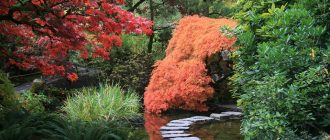Interested in painting from Japan? Find out about the deep love that the Japanese possess for the maple tree as we take a look into Japanese maple art.
The Japanese maple is considered to be an Asian shrub which is almost like a small tree. The physical characteristics of the maple tree have made a popular choice for people looking to enhance the aesthetics of their surroundings. The highly decorative reddish foliage seems to have a great appeal to people.
In Japan the maple tree has been taken as an ornamental shrub that has a whole field of art associated with it. The history of Japanese art reveals a wide collection of maple art that shows us how popular the shrub was in Japan. In fact maple art is still pretty much in practice in Japan.
The art of working with miniature trees is an age old practice in Japan and China. Although the bulk of the miniature plants grow on the mountains of China the Japanese too have their fair share of miniature plant art. The name that this field of art has been given for centuries is bonsai. Japanese bonsai is in many ways strikingly different from what you would find in China.
The Japanese maple is a symbol of grace personified. It represents elegance and a sense of tastefulness. With its branches spreading out horizontally the maple has quite a mood and generates an overwhelming feeling in the observer. The brilliant color of the maple is also something that attracts many people to the shrub.
Japanese Maple Leaves
One of the most appealing things about the maple is the shape of their leaves. The maple has highly artistic leaves that have a very unique texture. Furthermore this delicate artistic shrub is ever green; actually it’s ‘ever red’ but what I mean to say is that it grows all around the year.
Come spring season and you will find that buds of the maple start to swell in anticipation of fresh new leaves. In the summer these leaves generate a cool feeling with their fresh green color. It is around the autumn and winter season that the maple truly comes into its own color. With the winter gaining strength the maple sheds its leaves revealing the beautiful silhouette of the tree.
Although the flowering cherry and the black pine have been popular choices with regards to Japanese paintings the maple has been a source of inspiration due to its poetic symbolism. There exist great examples of court poetry from the 7th to the 13th century with the maple as the source of inspiration. The poetry flourished in the waka and tanka style through these years.
You will be able to find many poems and songs written about these unique maple trees in Japanese tradition. The phrase momiki-gari is commonly found in Japanese culture which actually means maple viewing or hunting. Visiting the mountains in the fall season in order to witness the brilliance of the wild maple trees is a common practice in Japan.
The red color that the maple tree takes on in winter has lent a great expression to the mountains during those times. The mountains are known as yama ga moeru which translates as the burning mountain in autumn. This is because the red colored maple trees make the mountain appear as though it is on fire from a distance.





